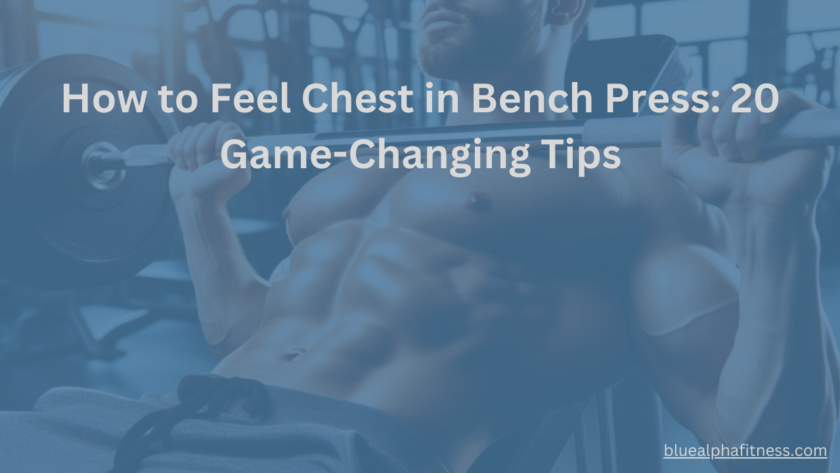Can’t feel your chest engaging during the bench press? You press hard, but your shoulders and triceps steal the show, leaving your chest barely activated.
It’s frustrating—like pushing a car that won’t start.
So, how do you actually feel your chest in the bench press?
To feel your chest in the bench press, start by refining your technique—adjusting your grip, controlling the bar path, and actively engaging your chest throughout each rep.
This article lays out 20 essential tips to help you maximize chest activation, strengthen your mind-muscle connection, and make every rep count.
No more wasted effort. No more guesswork. Just clear, actionable strategies to transform your bench press and finally get that deep chest burn.
Let’s begin.
How to Feel Chest in Bench Press: Step-by-Step Guide
Now, let’s break it down step by step so you can finally feel your chest working with every bench press rep.
1) Master the Setup
Tip 1: Position Your Feet
Ever tried building a house on shaky ground? Same idea with bench pressing.
Your feet are your foundation.
- Plant them firmly on the ground. Not just touching, but rooted like a tree. This isn’t just about balance – it’s about power.
- Feel the ground beneath you, push through your heels, and maintain that slight arch in your lower back. It’s not just for show; it’s your power base.
With your feet solid, you’re set to drive every rep with stability.
Tip 2: Grip Width
Finding the right grip is like tuning an instrument.
- Too wide, and you lose power.
- Too narrow, and your triceps take over.
Aim for a grip slightly wider than shoulder-width. This isn’t a one-size-fits-all – you’ll need to experiment.
Start with a wider grip and gradually adjust.
Feel the bar in your hands, notice where your chest feels the most engaged, and lock that in. This is where the magic truly comes to life.
Tip 3: Retract Your Scapula
Picture this: your shoulder blades are wings.
Pull them back and down, like you’re trying to squeeze a pencil between them.
This isn’t just about posture. It creates a stable platform, keeping your shoulders safe and putting your chest in the spotlight.
Hold this position throughout the lift.
It might feel awkward at first, but trust me, it’s a game-changer for chest engagement.
2) Optimize Your Technique
Tip 4: Elbow Position
Your elbows are like the rudder of a ship – they guide the way.
Keep them angled at 45 degrees to your body.
- Too wide, and you risk shoulder strain.
- Too narrow, and your triceps steal the show.
This angle strikes the perfect balance, maximizing chest involvement. Picture your elbows moving in a controlled arc, leading the bar to the lower part of your chest.
Tip 5: Bar Path
Think of the bar path as a curved track, not a straight line.
- Lower the bar to your chest, around the area of your sternum, not your neck.
- As you press up, guide the bar in a slight arc, finishing above your shoulders. This path mirrors the natural movement of your chest muscles.
Imagine painting a letter “J” with the bar – lower to the chest, up to the shoulders. This motion ensures your chest stays engaged throughout the lift.
Tip 6: Controlled Tempo
Speed kills – literally.
Rushing your reps is a surefire way to miss out on chest activation. Slow it down.
- Lower the bar slowly, taking 2-3 seconds. Feel the tension in your chest as you descend.
- Explode upwards, but with control. This tempo keeps your chest muscles under constant tension, building strength and size.
3) Incorporate Specific Exercises
Tip 7: Pre-Activation Exercises
Warming up isn’t just about getting loose. It’s about priming your muscles for action.
Before you hit the bench, try some band pull-aparts or chest flys. These exercises wake up your chest muscles, getting them ready for the main event.
It’s like stretching before a big game – you want to be at your best from the get-go.
Tip 8: Incline Bench Press
The incline bench press targets your upper chest, giving you that full, well-rounded look.
Set the bench at a moderate incline, around 30-45 degrees.
- Too steep, and it becomes a shoulder workout.
- Too flat, and you miss the upper chest.
Find the angle where you feel the most chest activation.
This variation not only builds strength but also enhances the aesthetic of your upper body.
Tip 9: Dumbbell Press Variations
Dumbbells offer freedom that a barbell can’t. They allow for a greater range of motion, meaning more muscle activation.
Try flat, incline, and decline dumbbell presses.
Each angle hits different parts of your chest, ensuring balanced development.
Picture your chest as a canvas, and dumbbells as your brush – use different strokes to create a masterpiece.
4) Utilize Advanced Techniques
Tip 10: Pause Reps
Momentum is your enemy.
It takes the load off your muscles, making the lift easier. So, enter pause reps.
- At the bottom of your press, pause for a second or two.
- Feel the stretch in your chest, then press up.
This technique eliminates momentum, forcing your chest to work harder.
It’s like hitting the brakes on a downhill slope – you control the lift, not the other way around.
Tip 11: Slow Eccentric Reps
The eccentric phase – or lowering the bar – is where muscle damage happens.
And muscle damage equals growth. Therefore, slow it down.
Take 3-5 seconds to lower the bar. Feel every inch of the descent.
This not only increases tension but also ensures you’re using your chest, not just dropping the weight.
It’s the difference between coasting and grinding.
Tip 12: Isometric Holds
Ever heard of time under tension? It’s a key factor in muscle growth.
Try holding the bar at the bottom of your press for 2-3 seconds.
This isometric hold keeps your chest muscles under tension, enhancing activation and strength.
It’s like holding a plank – the longer you hold, the stronger you get.
5) Focus on Mind-Muscle Connection
Tip 13: Visualize Chest Engagement
Your mind is a powerful tool. Use it.
- Imagine your chest muscles flexing with each rep. Close your eyes if it helps you focus.
- Picture your chest doing the work, not your arms.
Focusing your mind like this can really boost muscle activation.
Tip 14: Use Tactile Feedback
Sometimes, a little touch goes a long way.
Lightly tap your chest before and during the lift.
This tactile feedback increases awareness, helping you focus on chest activation.
It’s a simple trick but highly effective. Think of it as a reminder – “Hey, chest, this one’s for you.”
6) Adjust Training Variables
Tip 15: Volume and Intensity
Variety isn’t just the spice of life – it’s the key to muscle growth.
Mix up your rep ranges and weights.
- Do heavy sets with low reps to build strength.
- Follow up with lighter sets and higher reps for hypertrophy.
This combination targets different muscle fibers, ensuring comprehensive growth.
It’s like mixing weights and cardio – both have their place in a balanced routine.
Tip 16: Rest Periods
Rest is crucial, but how much is enough?
- For lighter sets, keep rest periods short – 60-90 seconds. This keeps the muscle under tension and increases metabolic stress.
- For heavy sets, give yourself 2-3 minutes. Full recovery means you can lift more weight, building strength and muscle.
It’s a balancing act – rest enough to recover, but not so much that you lose tension.
7) Implement Accessory Movements
Tip 17: Chest Flys
Isolation exercises like chest flys are perfect for targeting specific muscles.
- Try flat, incline, and cable flys. Focus on a full range of motion, bringing your arms together at the top and stretching at the bottom.
- This movement isolates the chest, enhancing growth and definition. Think of it as fine-tuning – you’re sculpting every detail.
Tip 18: Push-Ups
Push-ups aren’t just for beginners. They’re a powerful chest exercise.
- Try variations like decline push-ups to increase difficulty. Add weight or use a resistance band for more challenge.
- Push-ups enhance chest activation and endurance. They’re versatile, effective, and you can do them anywhere. It’s the Swiss Army knife of chest exercises.
Tip 19: Dips
Dips are a compound movement that hit the chest hard.
- Lean forward to target the chest more than the triceps.
- Control the movement, lowering yourself slowly and pressing up powerfully.
- Avoid locking out your elbows to keep the tension on your chest.
Dips build strength, size, and endurance. They’re tough, but the results are worth it.
8) Monitor and Progress
Tip 20: Track Your Progress
Keep a training log.
Write down your weights, sets, and reps. Note how your chest feels during and after each workout.
This isn’t just about numbers – it’s about tracking your journey. Adjust your routine based on what you see.
If something’s not working, change it. If you’re seeing progress, keep at it. This log is your roadmap to success.
For even faster progress, check out our guide on How to Increase Bench Press Fast: 10 Proven Tips to enhance your performance and reach your goals quicker.
FAQs on How to Feel Chest in Bench Press: Your Top Questions Answered
Now that you are well equipped with the ultimate tips on how to feel your chest in bench press, let’s answer a couple of Qs you might have in mind.
1) How to lift heavy in bench press?
To lift heavy in bench press, focus on progressive overload, proper form, and consistent training. Incorporate compound movements and accessory exercises to build overall strength.
2) How do you know if your bench press is strong?
You know your bench press is strong if you can lift 1.5 times your body weight. Additionally, consistency in form and the ability to handle heavy weights without assistance are good indicators.
3) How to increase your bench press?
To increase your bench press, follow a structured training program with progressive overload. Incorporate accessory exercises, improve your technique, and ensure adequate recovery.
4) What is the secret to bench press?
The secret to bench press is maintaining proper form, engaging your chest muscles effectively, and progressively increasing the weight. Consistent training and focusing on weak points also play crucial roles.
5) Do push-ups increase bench?
Yes, push-ups can increase bench press strength. Push-ups help build chest, shoulder, and tricep muscles, which are essential for bench pressing.
6) How many push-ups equal a bench press?
There isn’t a direct equivalence, but doing high-rep push-ups can complement your bench press routine. Push-ups are more of an endurance exercise, while bench press focuses on strength.
7) Can I do push-ups and bench on the same day?
Yes, you can do push-ups and bench press on the same day. Ensure you manage your volume and intensity to avoid overtraining.
8) How many minutes should you wait between bench press?
You should wait 2 to 3 minutes between bench press sets. This rest period allows for adequate recovery and maintains performance during heavy lifts.
9) Which bench press should I do first?
You should do the flat bench press first. Starting with the flat bench press allows you to lift the heaviest weights while you are fresh, ensuring maximum chest activation.
10) How do I maximize my chest activation on bench press?
To maximize your chest activation on bench press, focus on proper form, including scapular retraction, correct hand and elbow positioning, and controlled movements. Visualize your chest muscles working and ensure you pause at the bottom of the lift.
11) Why is my chest not activating on the bench?
Your chest may not be activating on the bench due to improper form, such as incorrect hand placement or elbow flaring. Additionally, lack of mind-muscle connection and inadequate warm-up can prevent effective chest engagement.
12) How do I activate my upper chest in bench press?
To activate your upper chest in bench press, use an incline bench press at a 30-45 degree angle. Focus on squeezing your upper chest muscles during each lift.
13) How can I increase my bench press intensity?
To increase your bench press intensity, incorporate progressive overload by gradually increasing the weight you lift. Use accessories like resistance bands or chains and vary your rep ranges to challenge your muscles differently.
14) Where should you feel chest press?
You should feel chest press primarily in your pectoral muscles. Secondary muscle groups like the shoulders and triceps will also engage, but the focus should remain on the chest.
15) Why is my chest not growing when I bench press?
Your chest may not be growing when you bench press due to insufficient progressive overload, poor form, or lack of variation in your workout routine. Ensure you are also consuming enough protein and calories to support muscle growth.
16) How can I improve my upper chest activation?
To improve your upper chest activation, include exercises like incline bench press and incline dumbbell flyes in your routine. Focus on squeezing your upper chest muscles during each repetition.
17) Where do you touch your chest when benching?
You should touch the bar to your mid to lower chest when benching. This ensures proper form and maximizes chest activation.
18) How do I get a bigger chest with bench press?
To get a bigger chest with bench press, use a combination of flat, incline, and decline bench press variations. Ensure you progressively increase the weight and maintain proper form throughout your lifts.
19) Where should you look when bench pressing?
You should look up at a fixed point on the ceiling or slightly forward. Keeping a consistent focal point helps maintain proper head and spine alignment.
20) Why am I strong but can’t bench press?
You might be strong but can’t bench press due to poor technique, lack of chest activation, or muscle imbalances. Focus on improving your form and engaging your chest muscles correctly.
21) Is it better to bench press fast or slow?
It is better to bench press with a controlled tempo. Lower the bar slowly to increase time under tension and press up with controlled speed to maximize muscle engagement and reduce injury risk.
22) How do you fix a weak bench press?
To fix a weak bench press, identify and address weak points, incorporate accessory exercises to strengthen supporting muscles, and ensure you’re using proper form. Regularly practicing bench press variations can also help.
Final Word on How to Feel Chest in Bench Press
You’ve been busting your butt on the bench press, yet somehow, your chest just isn’t feeling it.
Frustration? Oh yeah, we’ve all been there.
It’s like cooking a gourmet meal and having it taste bland – infuriating, right?
You’re probably thinking, “Why is this so tough? What am I missing?”
Here’s the thing: you’re not alone, and you’re not failing. Often, it’s the tiniest changes that have the biggest impact.
You’ve just armed yourself with 20 game-changing tips to finally unlock that chest activation you’ve been craving.
Remember, every rep, every adjustment, and every drop of sweat is moving you closer to your goal.
These tips aren’t just tricks – they’re your blueprint for success.
Stay consistent, stay focused, and watch your chest transform.
You’ve got this. Now go out there and make that bench press count.
Stand tall, proud, and ready to crush it!



